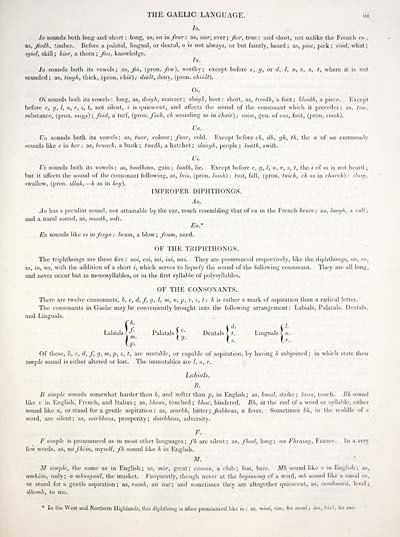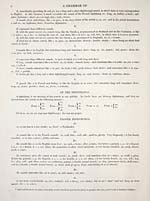Download files
Complete book:
Individual page:
Thumbnail gallery: Grid view | List view

THE GAELIC LANGUAGE. lii
/o.
/o sounds both long and short: long, as, ea in fear; as, sior, ever; fior, true: and short, not unlike the French cu ;
as, Jiodh, timber. Before a palatal, lingual, or dental, o is not always, or but faintly, heard ; as, jiioc, pick ; ciod, what;
sgiol, skill ; bior, a thorn ; Jios, knowledge.
lu.
Ill sounds both its vowels; as, Jiù, ([tron. feiv), worthy; except before c, y, or cl, I, n, r, s, t, where it is not
sounded; as, tiuyh, thick, (pron. chiv); diùlt, deny, (pron. chiklt).
Oi.
Oi sounds both its vowels: long, as, doiyh, manner; sloigh, host: short, as, Iroidh, a foot; hloidh, a piece. Except
before c, g, I, n, r, s, t, not silent, i is quiescent, and affects the sound of the consonant which it precedes; as, toic,
.substance, (pron. toix"); foid, a turf, (pron./ocA, c/j sounding as in chair); coise, gen. of cas, foot, (pron. coish).
Ua.
Ua sounds both its vowels; as, tuar, colonv ; fiinr, cold. Except before ch, dh, gh, ill, the o of ua commonly
sounds like e in her ; as, hruach, a bank; tuadii, a hatchet; slaagli, people; luath, swift.
Ui.
Ui sounds both its vowels; as, buidhinn, gain ; luidh, lie. Except before c, g, I, n, r, s, t, the i of ui is not heard ;
but it affects the sound of the consonant following, as, luis, (pron. hash) ; tuit, fall, (pron. tuich, ch as in church) ; sluig,
swallow, (pron. slluk, — k as in key).
IMPROPER DIPHTHONGS.
Ao.
Ao has a peculiar sound, not attainable by the ear, much resembling that of cu in the French heure ; as, laogh, a call ;
and a nasal sound, as, maoth, soft.
Eu*
Eu sounds like ei m feign; beam, a blow; feum, need.
OF THE TRIPHTHONGS.
The triphthongs are these five : aoi, eoi, iai, iui, uai. They are pronounced respectively, like the diphthongs, ao, eo,
ia, iu, ua, with the addition of a short i, which serves to liquefy the sound of the following consonant. They are all long,
and never occur but in monosyllables, or in the first syllable of polysyllables.
OF THE CONSONANTS.
There are twelve consonants, b, c, d, f g, I, m, n, p, r, s, t ; h is rather a mark of aspiration than a radical letter.
The consonants in Gaelic may be conveniently brought into the following arrangement: Labials, Palatals, Dentals,
and Linguals.
f/i C (''• ('■
Labials-? ■'■ Palatals < ' Dentals x<. Linguals nk.
l;: ^3- h. \r.
Of these, b, c, d, f, g, m, p, s, t, are mutable, or capable of aspiration, by having h subjoined ; in which state their
simple sound is either altered or lost. The immutables are /, n, r.
Labials.
B.
B simple sounds somewhat harder than b, and softer than p, in English ; as, buail, strike ; bean, touch. Bk sound
like V in English, French, and Italian; as, hhean, touched; bhac, hindered. Bh, at the end of a word or syllable, either
sound like ?<, or stand for a gentle aspiration; as, searbh, hitter; fabhras, a fever. Sometimes bh, in the middle of a
word, are silent; as, soirbheas, prosperity; doirbheas, adversity.
F.
F simple is pronounced as in most other languages; fh are silent; as, fluid, long; an Fhraiiig, France. In a very
few words, as, mifhein, myself, fh sound like h in English.
M.
M simple, the same as in English; as, mhr, great; caman, a club; lom, bare. Mh sound like v in English; as,
amhàin, only; a mhusgaid, the musket. Frequently, though never at the begiiming of a word, mh sound like a nasal oo,
or stand for a gentle aspiration ; as, ranih, an oar ; and sometimes they are altogether quiescent, as, comhnard, level ;
dhomh, to me.
* In the West and Nortliem Highlands, this diphthong is often pronounced like ia ; as, mtail, size, for meud ; iuii, binl, for euii.
/o.
/o sounds both long and short: long, as, ea in fear; as, sior, ever; fior, true: and short, not unlike the French cu ;
as, Jiodh, timber. Before a palatal, lingual, or dental, o is not always, or but faintly, heard ; as, jiioc, pick ; ciod, what;
sgiol, skill ; bior, a thorn ; Jios, knowledge.
lu.
Ill sounds both its vowels; as, Jiù, ([tron. feiv), worthy; except before c, y, or cl, I, n, r, s, t, where it is not
sounded; as, tiuyh, thick, (pron. chiv); diùlt, deny, (pron. chiklt).
Oi.
Oi sounds both its vowels: long, as, doiyh, manner; sloigh, host: short, as, Iroidh, a foot; hloidh, a piece. Except
before c, g, I, n, r, s, t, not silent, i is quiescent, and affects the sound of the consonant which it precedes; as, toic,
.substance, (pron. toix"); foid, a turf, (pron./ocA, c/j sounding as in chair); coise, gen. of cas, foot, (pron. coish).
Ua.
Ua sounds both its vowels; as, tuar, colonv ; fiinr, cold. Except before ch, dh, gh, ill, the o of ua commonly
sounds like e in her ; as, hruach, a bank; tuadii, a hatchet; slaagli, people; luath, swift.
Ui.
Ui sounds both its vowels; as, buidhinn, gain ; luidh, lie. Except before c, g, I, n, r, s, t, the i of ui is not heard ;
but it affects the sound of the consonant following, as, luis, (pron. hash) ; tuit, fall, (pron. tuich, ch as in church) ; sluig,
swallow, (pron. slluk, — k as in key).
IMPROPER DIPHTHONGS.
Ao.
Ao has a peculiar sound, not attainable by the ear, much resembling that of cu in the French heure ; as, laogh, a call ;
and a nasal sound, as, maoth, soft.
Eu*
Eu sounds like ei m feign; beam, a blow; feum, need.
OF THE TRIPHTHONGS.
The triphthongs are these five : aoi, eoi, iai, iui, uai. They are pronounced respectively, like the diphthongs, ao, eo,
ia, iu, ua, with the addition of a short i, which serves to liquefy the sound of the following consonant. They are all long,
and never occur but in monosyllables, or in the first syllable of polysyllables.
OF THE CONSONANTS.
There are twelve consonants, b, c, d, f g, I, m, n, p, r, s, t ; h is rather a mark of aspiration than a radical letter.
The consonants in Gaelic may be conveniently brought into the following arrangement: Labials, Palatals, Dentals,
and Linguals.
f/i C (''• ('■
Labials-? ■'■ Palatals < ' Dentals x<. Linguals nk.
l;: ^3- h. \r.
Of these, b, c, d, f, g, m, p, s, t, are mutable, or capable of aspiration, by having h subjoined ; in which state their
simple sound is either altered or lost. The immutables are /, n, r.
Labials.
B.
B simple sounds somewhat harder than b, and softer than p, in English ; as, buail, strike ; bean, touch. Bk sound
like V in English, French, and Italian; as, hhean, touched; bhac, hindered. Bh, at the end of a word or syllable, either
sound like ?<, or stand for a gentle aspiration; as, searbh, hitter; fabhras, a fever. Sometimes bh, in the middle of a
word, are silent; as, soirbheas, prosperity; doirbheas, adversity.
F.
F simple is pronounced as in most other languages; fh are silent; as, fluid, long; an Fhraiiig, France. In a very
few words, as, mifhein, myself, fh sound like h in English.
M.
M simple, the same as in English; as, mhr, great; caman, a club; lom, bare. Mh sound like v in English; as,
amhàin, only; a mhusgaid, the musket. Frequently, though never at the begiiming of a word, mh sound like a nasal oo,
or stand for a gentle aspiration ; as, ranih, an oar ; and sometimes they are altogether quiescent, as, comhnard, level ;
dhomh, to me.
* In the West and Nortliem Highlands, this diphthong is often pronounced like ia ; as, mtail, size, for meud ; iuii, binl, for euii.
Set display mode to: Large image | Transcription
Images and transcriptions on this page, including medium image downloads, may be used under the Creative Commons Attribution 4.0 International Licence unless otherwise stated. ![]()
| Early Gaelic Book Collections > Blair Collection > Gaelic dictionary, in two parts > (25) |
|---|
| Permanent URL | https://digital.nls.uk/79284449 |
|---|
| Description | A selection of books from a collection of more than 500 titles, mostly on religious and literary topics. Also includes some material dealing with other Celtic languages and societies. Collection created towards the end of the 19th century by Lady Evelyn Stewart Murray. |
|---|
| Description | Selected items from five 'Special and Named Printed Collections'. Includes books in Gaelic and other Celtic languages, works about the Gaels, their languages, literature, culture and history. |
|---|

